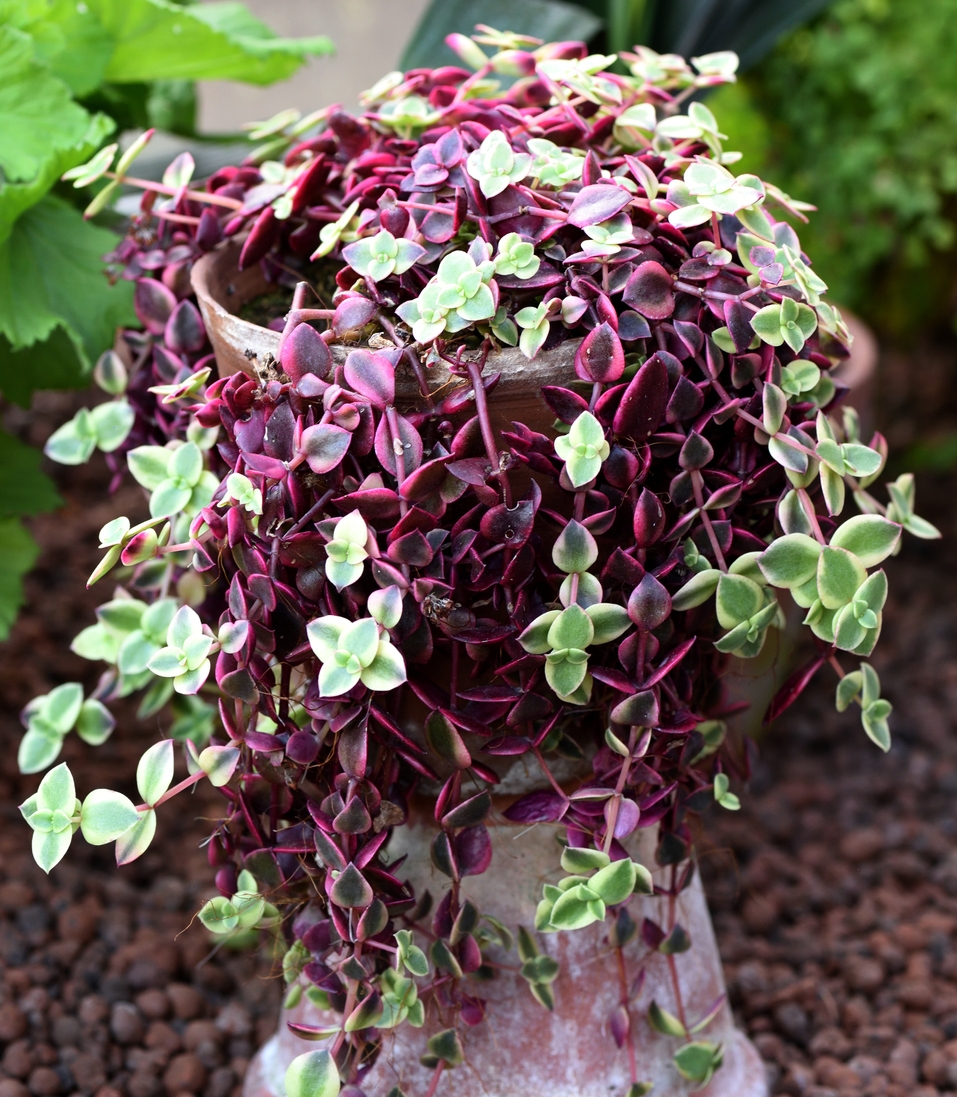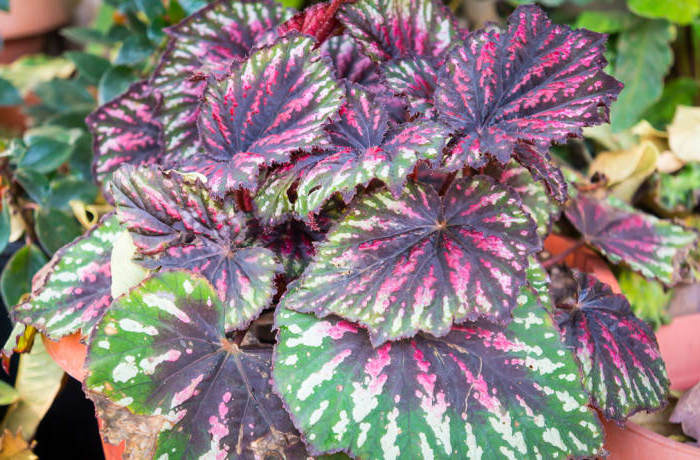Houseplants are good air purifiers and can brighten up any room in the house. While many people like pink flowers, pink houseplants are becoming more popular, too.

In feng sui, pink is the color of love according to TheSpruce. This includes self-love and platonic love as well as romantic love.
While growing in popularity, a pink houseplant is still unique enough to make an interesting statement.
Pink Houseplants Versus Pink Flowers
Pink houseplants may have pink flowers, but not all of them are pink flowering houseplants. They all have pink leaves.
Houseplants have been selectively bred to have a variety of pink foliage in a variety of patterns. Because houseplants are protected from the elements, pests, and diseases, they can afford to have more pink foliage than outside plants.
Pink foliage helps with photosynthesis by absorbing light and passing that energy to the green chlorophyll in a plant but cannot photosynthesize by itself.
Houseplants with pink leaves are thus at an evolutionary disadvantage. Our care protects the plant from this disadvantage.
Keeping Pink Houseplants Humid Enough
Many pink houseplants come from very humid environments. Houses are not typically as humid, which can be a problem. To increase the humidity around the plant you can mist the leaves.
However, that leaves the plant vulnerable to mildew and molds that grow on wet leaves.
A better way to increase the humidity is to use a pebble tray.
Take a saucer that is large enough to hold the plant and saucer. Fill it with pebbles. Pour in enough water to come just below the top of the pebbles.
Set the saucer of the plant on the top of the pebbles. As the water evaporates, it creates a humid microclimate.
Make sure you refill the water in the pebble tray regularly.
What Makes Plants or Flowers Pink?
Humans see pink because it is reflected from the plant surface. Pigments in the plant reflect this wave of light. Plants usually use different colors to attract pollinators to their pollen. That is why so many flowers are pink.
Pink is caused by a group of pigments called anthocyanins that cause colors from red to orange and violet to blue.
Some of these pigments absorb ultraviolet light, which many insects see better than light that is visible to us.
Colors of pink
Pink foliage comes in a variety of shades of pink. Some of the most common are light pink, pink, and dark pink.
Most pink houseplants have pink and green leaves, as some green is required for photosynthesis.
The pink in the foliage really makes it pop. Here are some examples of the different shades of pink found in houseplants.
Light pink

Spiderworts come in pink, and the cultivar Tradescantia albiflora (nanouk) has light pink leaves.
Originally from Mexico, Central and South America, this type of spiderwort was developed in the Netherlands. Nanouk needs bright indirect light. Too little light will cause the pink to fade. Too much will burn the plant.
Pink Tradescantia houseplants are small, reaching a height of six to twelve inches. The plant needs weekly waterings. The sap of this plant can cause skin irritation and gastric distress in humans and pets.

The pink polka dot plant, Hypoestes phyllostachya (pink brocade) has a pink base and polka dots and stripes of green. It will fade if it gets too much light. Bright, indirect light is best for a pink polka dot plant.
The plant grows one to two feet tall and one to two feet wide. It is from Madagascar and needs well-drained soil.
Keep the soil moist but not soggy. Let the soil get dryer in the winter while it is dormant, but do not let it dry out completely.
Feed these plants a houseplant fertilizer once a month while the plant is growing. Do not fertilize when the plant is dormant.
Pink

The Aglaonema (Pink Splash) has vibrant pink variegated leaves. It needs bright light and frequent watering to keep the soil evenly moist.
Too much sun will burn the leaves. Water the plant when the top half of the soil is dry. Water it until water flows through the drainage holes.
Fertilize once a month during the spring and summer with a water-soluble houseplant fertilizer. This plant is moderately toxic to humans and pets.

The Pink Princess Philodendron, Philodendron erubescens (pink princess), is a houseplant with pink and green leaves. It needs loamy soil and bright, indirect light.
Too much shade and the pink turns green. From South America, this plant grows two to four feet tall and two to four feet wide. Let the top half of the soil dry out between waterings.
When watering, let the water come out of the drainage holes before you stop. Fertilize monthly with a water-soluble houseplant fertilizer during the spring and summer.
Do not fertilize in the fall or winter.
Dark Pink

The prayer plant comes in many colors of pink, but the Calathea (Dottie) has rich pink magenta hues on the leaves.
They require humid, warm air and need partial sun to shade. Do not place the plant in direct light or it will burn the leaves and fade the pink.
This prayer plant can be difficult to grow, but supplementing the humidity in the air helps them.
Water when the top two inches of soil are beginning to dry out. Use well-drained potting soil as the plant will not tolerate sitting in water.
Fertilize once a month during spring and summer. Use a houseplant fertilizer at half strength as this plant is sensitive to over-fertilization. Do not fertilize in the fall and winter.

The bloodleaf plant, Iresine herbstii brilliantissima, has dark red and pink leaves. When young, these plants like partial shade.
They grow more tolerant of light as they mature, but are margin plants, growing at the edge of a forest so that direct sunlight will burn them. Indirect, bright light is best for mature plants.
Native to South America, the bloodleaf plant is rare in North America. It grows twelve to eighteen inches tall.
Fertilize once every three weeks. Keep the soil moist. These plants need warm, humid conditions.
Patterns of Pink
Pink foliage is not all pink. It must have some green on the leaves to do photosynthesis. With many patterns of pink leaves, there is sure to be something you like. Here are the most common foliage patterns found in pink houseplants.
Variegated
Variegated plants have foliage that is edged or patterned in a second color. This is usually green leaves with white as the second color, but pink and green houseplants often have variegated patterns.

The calico kitten plant, Crassula pellucida variegata ‘Calico Kitten’, has dark pink variegated leaves.
It is native to South Africa. It needs bright light inside. Calico kitten plants need a well-draining soil formulated for succulents. Water when the top inch of the soil is dry. Do not overwater.
During the growing season, fertilize with a weak houseplant fertilizer every three weeks.
Do not fertilize during the fall and winter. The plant will be two to four inches tall at maturity.
Pink Spots

Pink polka dot plants, Hypestes phyllostachya, are, as the name suggests, a houseplant with pink spots on green leaves. See care instructions above.
Pink Blush

This is usually a pink color at the base or in the center of the leaves. The begonia Begonia rex ‘Pink Charming’ has a blush of pink in the leaves where the stem meets the leaf.
Pink begonia houseplants grow to be ten to twelve inches tall and about the same in width.
They need bright indirect sunlight. Let the soil surface dry out slightly between waterings.
Fertilize with half-strength houseplant fertilizer every two weeks. Begonias need a humidity of around fifty percent.
Use a pebble tray for that, as misting the leaves can lead to diseases in this plant.
Pink Leaves with Green Veins

Caladium pink symphony has bright pink leaves with green veins. This creates a stunning pink leaf houseplant.
Caladiums are native to Central and South America. Indoors, they require bright indirect sunlight. Caladium’s leaves die back after a few months and it enters a dormant period. After the dormant period, the leaves sprout again.
Water enough to keep the soil evenly moist during the growing season, usually spring and summer.
Do not water during dormancy, but resume watering in the spring so the leaves will begin to grow again.
Fertilize with water-soluble houseplant fertilizer every two weeks during the spring and summer.
Do not fertilize when the plant is dormant. These plants are toxic to humans and pets.
Uses for Pink Houseplants

Pink houseplants have many uses. Here are some ways to use them in your home.
Shade Plants
While some pink houseplants need bright light, many of them thrive in partial shade. If your windowsills and sunny places are full, try these plants in a less sunny spot where other plants won’t grow.
Container Plants
Pink plants make great thriller plants in containers. Place them between green-leaved plants to make your container pop. Make sure you match plants with ones that need a similar amount of light and water so all the plants thrive.
Bathroom Plants
Many plants need more light than they get in the bathroom. Pink plants that need a humid atmosphere and less light, such as spiderwort, can fill your bathroom with thriving houseplants.
Conclusion
Pink houseplants are becoming more common. However, they are still rare enough to add a unique touch to your home.
Use them as specimen plants, in containers, and as shade-loving plants in bathrooms.
While the sunlight requirements vary, you will need to water and fertilize them just like their green cousins.
Frequently Asked Questions
We get many of the same questions about pink houseplants from our readers. Here are the answers to the frequently asked questions.
Many pink houseplants can be bought at big box stores, but for some of the rarer ones, you will have to go to a nursery or order them online.
No, some of them are easy to grow. Try spiderworts, the pink polka dot plant, and caladiums.
Most houseplants with pink foliage are grown from cuttings. Cut the stem just below a node.
Make sure the cutting has two leaves and is four to six inches long. Place the cutting in potting soil then water it in.
Cover the pot with a plastic bag and place the pot in a warm, dark area. Keep the soil moist. In about three weeks, the cutting should have roots. Remove the bag as soon as the plant roots and grow normally.





